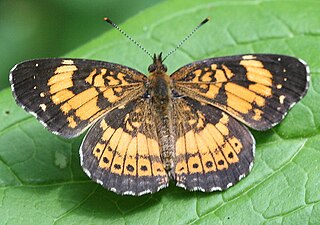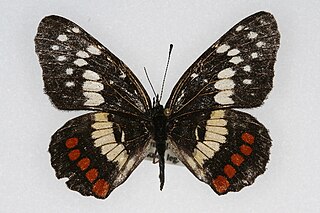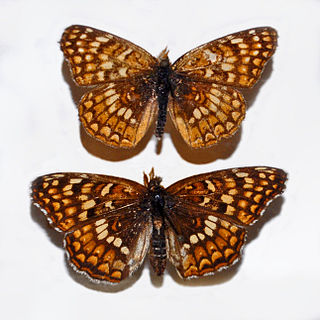
Castilleja, commonly known as paintbrush, Indian paintbrush, or prairie-fire, is a genus of about 200 species of annual and perennial herbaceous plants native to the west of the Americas from Alaska south to the Andes, northern Asia, and one species as far west as the Kola Peninsula in northwestern Russia. These plants are classified in the broomrape family Orobanchaceae. They are hemiparasitic on the roots of grasses and forbs. The generic name honors Spanish botanist Domingo Castillejo.

Chlosyne gorgone, the gorgone checkerspot, is a species of Nymphalinae butterfly that occurs in North America.

Castilleja attenuata is a species of Indian paintbrush, known by the common names valley tassels, attenuate Indian paintbrush, and narrowleaf Owl's-clover. It is native to western North America from British Columbia, through California, to Baja California, where it grows in grasslands and open woodland habitats.

Chlosyne lacinia, the bordered patch or sunflower patch, is a North and South American butterfly in the family Nymphalidae.

Chlosyne is a genus of butterflies from North and South America in the family Nymphalidae.

Schinia pulchripennis, or the common flower moth, is a moth of the family Noctuidae that is distributed throughout North America, including California and Nevada.

Chlosyne harrisii, or Harris's checkerspot, is a member of the family Nymphalidae that is found in North America. They range from the Canadian Atlantic provinces, excluding Newfoundland and Labrador, to Manitoba and North Dakota south to West Virginia and Ohio. They can often be seen in bogs, meadows and almost anywhere else its host plant occurs. The typical elevations for this species range from 0 to 1,742 feet (531 m). It is listed as a species of special concern and believed extirpated in the US state of Connecticut.

Erynnis icelus, also known as the dreamy duskywing or aspen dusky wing, is a species of butterfly in the family Hesperiidae. It is found in boreal North America, from the Northwest Territories east across southern Canada to Nova Scotia, south in the western mountains to southern Arizona and southern New Mexico, south in the east to Arkansas, north-eastern Alabama and northern Georgia.

Texola elada, the Elada checkerspot, is a species of butterfly in the brush-footed butterfly family, Nymphalidae. It is found from southern Mexico north to central Texas and central Arizona in the United States.

Chlosyne whitneyi, the rockslide checkerspot or Sierra Nevada checkerspot, is a butterfly of the family Nymphalidae. It is found in western North America from British Columbia and Alberta south, in the mountains, to California and Colorado.

Chlosyne ehrenbergii, the white-rayed checkerspot, white-rayed patch or Ehrenberg's patch, is a butterfly of the family Nymphalidae. It is found in Mexico.

Chlosyne marina, the red-spotted patch or marina checkerspot, is a butterfly of the family Nymphalidae. It is found in Mexico. Rare strays can be found as far north as southern Arizona and southern Texas.

Chlosyne leanira, the leanira checkerspot, is a butterfly of the family Nymphalidae. It is found in North America from western Oregon south to California, Nevada, Utah and western Colorado, as well as Baja California. The wingspan is 33–40 mm. Generally, females are larger than males, but males have a more apparent red color to their wings.
Ganyra howarthi, Howarth's white, is a butterfly in the family Pieridae. It is found along the coast in the southern half of Baja California and Sonora in Mexico. It is also found in extreme southern Arizona. The habitat consists of thorn forests and desert scrubs.

Eupithecia nimbicolor is a moth in the family Geometridae first described by George Duryea Hulst in 1896. It is found in North America from eastern Newfoundland and Labrador to western British Columbia and from Alaska to Arizona.

Castilleja integra, with the common names orange paintbrush, Southwestern paintbrush, and wholeleaf paintbrush, is a partially parasitic herbaceous perennial plant native to the Southwestern United States and Northern Mexico. The species produces a relatively large amount of nectar and is attractive to hummingbirds. It is better suited to cultivation than most other species in the paintbrush genus (Castilleja) and is therefor used in xeriscape gardens and naturalistic meadows, even outside its native range.

Chlosyne californica, the California patch, is a butterfly of the family Nymphalidae found in the Southwestern United States and Mexico. It lives in desert washes and canyons in regions between southern Nevada south to southwestern Arizona, southeastern California, Baja California and Sonora.

Chlosyne gabbii, or Gabb's checkerspot, is a butterfly from the family Nymphalidae.



















